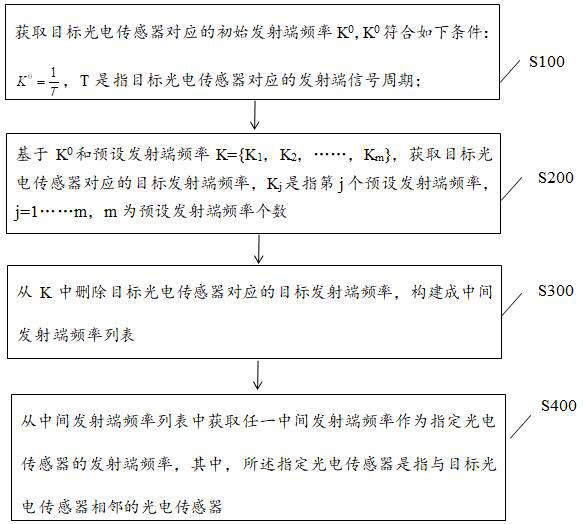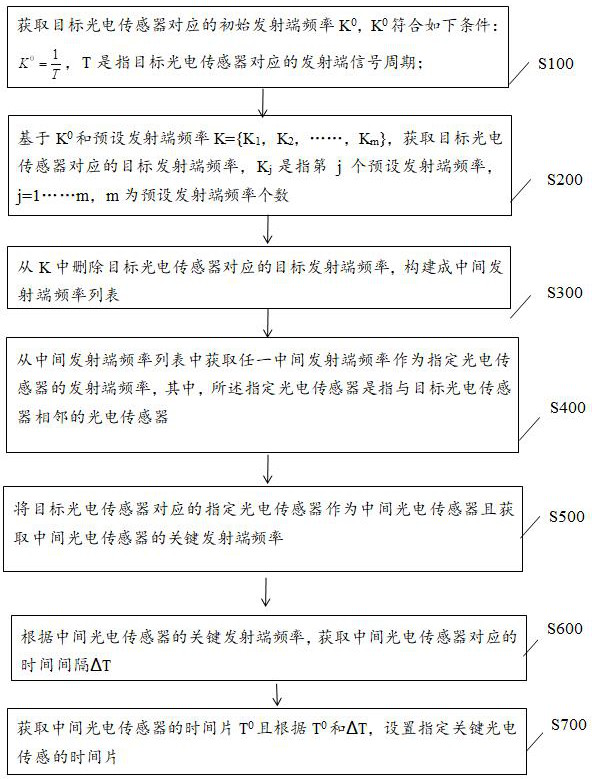A kind of anti-interference method, equipment and medium of diffuse reflection photoelectric sensor
A photoelectric sensor and diffuse reflection technology, which is applied in the field of intelligent sensors, can solve the problems of affecting the signal frequency of the through-beam photoelectric sensor, reducing the working accuracy and efficiency, and low working efficiency, so as to reduce the design complexity and improve the working accuracy and efficiency, the effect of improving work efficiency
- Summary
- Abstract
- Description
- Claims
- Application Information
AI Technical Summary
Problems solved by technology
Method used
Image
Examples
Embodiment 1
[0023] like figure 1 As shown, the first embodiment provides an anti-interference method for a diffuse reflection photoelectric sensor, and the method includes the following steps:
[0024] S100, obtain the initial transmitter frequency K corresponding to the target photoelectric sensor 0 , K 0 Meet the following conditions:
[0025] , T refers to the signal period of the transmitting end corresponding to the target photoelectric sensor; the signal period of the transmitting end corresponding to the target photoelectric sensor is the period of the light signal emitted by the transmitting end in any target photoelectric sensor.
[0026] Specifically, the target photoelectric sensor refers to any one of n photoelectric sensors, each photoelectric sensor is a diffuse reflection photoelectric sensor, and the diffuse reflection photoelectric sensor at least includes: a transmitting end and a receiving end located on the same side, and a detection circuit , wherein the transmit...
Embodiment 2
[0059] like figure 2 As shown, the second embodiment provides an anti-interference method for a diffuse reflection photoelectric sensor, the method further includes the following steps in addition to S100-S400:
[0060] S500, take the designated photoelectric sensor corresponding to the target photoelectric sensor as the intermediate photoelectric sensor and obtain the key transmitting end frequency of the intermediate photoelectric sensor; it can be understood as: the key transmitting end frequency of the designated photoelectric sensor is the key transmitting end frequency of the intermediate photoelectric sensor.
[0061] S600. Obtain the time interval ΔT corresponding to the intermediate photoelectric sensor according to the key transmitter frequency of the intermediate photoelectric sensor, where ΔT meets the following conditions:
[0062] , where S is a preset parameter, and T' is the time period corresponding to the intermediate photoelectric sensor.
[0063] Specif...
PUM
 Login to View More
Login to View More Abstract
Description
Claims
Application Information
 Login to View More
Login to View More - R&D
- Intellectual Property
- Life Sciences
- Materials
- Tech Scout
- Unparalleled Data Quality
- Higher Quality Content
- 60% Fewer Hallucinations
Browse by: Latest US Patents, China's latest patents, Technical Efficacy Thesaurus, Application Domain, Technology Topic, Popular Technical Reports.
© 2025 PatSnap. All rights reserved.Legal|Privacy policy|Modern Slavery Act Transparency Statement|Sitemap|About US| Contact US: help@patsnap.com


